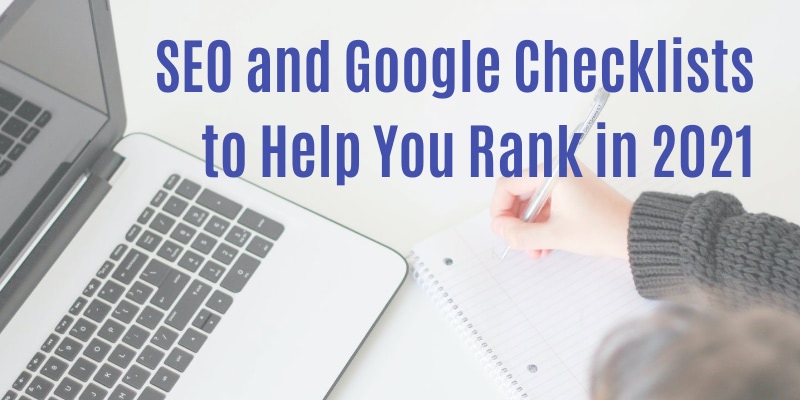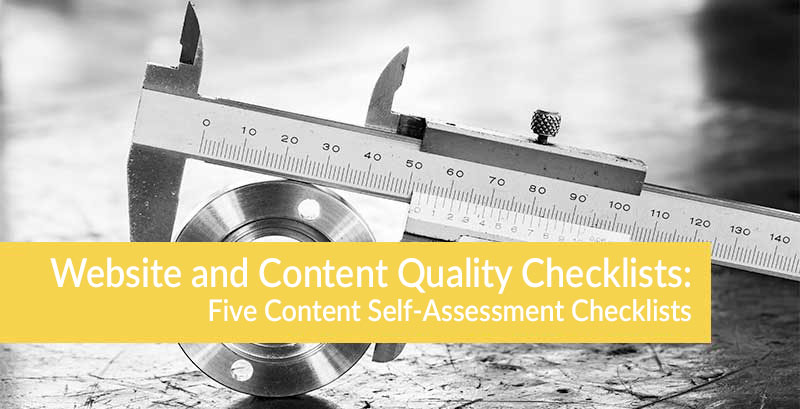What do you want to accomplish in 2021? Maybe you want to rank higher in Google search results or increase your click-throughs from blogs and social posts or grow your newsletter subscribers.
These targets are possible. But they do not happen with magic.
In May, Google is rolling out its Page Experience update and this means if you want to meet your SEO, content, and search goals, you need to get busy now. And this is why we’re focusing on the essentials – the things you must do to be ready for the May 2021 Google Page Experience update and a 2021 SEO checklist to help you rank and get clicked.

How to Get Ready for the May 2021 Google Page Experience Update
To get ready for the May 2021 Google Page Experience update, follow our 7-step checklist:
- Be Mobile-Friendly. Make sure your website is easy to use on mobile devices. This update puts a priority on a positive user experience. And Google wants its search results to be populated with URLs that make it simple for readers to get the answers they want.
To Do: test your website on multiple mobile devices. Make sure it’s easy for people to find information, buy products/services, and to contact you. Use Google’s Mobile-Friendly Test to measure site responsiveness. - Review and Update Content. A positive user experience comes down to the words on the page. A fast website and easy navigation do not mean much if your content is lacking. Above all else, Google still wants to give readers search engine results that answer questions clearly and succinctly.
To Do: read your content, update outdated blogs and articles, fix typos, make sure all content delivers on search intent, test links, and review your keywords. Make sure your content meets guidelines for E-A-T and YMYL. - Test Your Site Speed. Google wants your page to load quickly. Largest Contentful Paint (LCP) is a core web vital metric used by Google to determine your site speed. Your page needs to load within 2.5 seconds.
To Do: read what Google says about LCP and use Google’s Page Speed Insights tool to measure your site speed. - Get Rid of Annoying Pop Ups. Disable any ads or pop-ups that make it hard for people to read your content. Google wants to rank pages that give readers an easy reading experience. Pop-ups or interstitials that block the entire page or are hard to close will hurt your ranking.
To Do: compare your pop ups to the examples provided by Google. Make sure it’s easy to see your page content and to close the interstitials. - Make It Safe and Secure. The May 2021 Google update puts a large emphasis on a safe and secure browsing experience. Your site must be free of malicious content such as social engineering scams, spyware, or false information. Additionally, you need to give readers a secure browsing experience.
To Do: use HTTPS and ensure your site is secure. In the Google Search Console, open the Security Issues Report to learn the safe browsing status of your website. - Reduce Bounce Rate. Bounce rate is not a Page Experience metric, but it does speak to the value of your page content. Google uses bounce rate to understand how well the page delivers value to users and the quality of the page experience.
To Do: find out your bounce rate and if it’s above 40%, take steps to lower it. Make it easy for people to navigate your site, use images and videos to engage readers, make sure your content delivers on search intent, use internal links to encourage people to stay on your site, and make it easy for people to contact you. - Learn About Page Experience and Core Web Vitals Metrics. To understand why these actions are important, you need to understand what is coming in the May 2021 Google Page Experience update.
To Do: read Google, Page Experience, Core Web Vitals, and Your Website and Google Passage Ranking and BERT: How To Make Sure Your Content Keeps Google Happy. Call us to talk about Page Experience and your website.
Read what Google says about Page Experience and when the new update will be rolled out.

2021 SEO Checklist
Getting SEO right is essential to your Google ranking today and after Google launches the Page Experience update. Use this SEO checklist to make sure you’re getting the most out of SEO, search, content, and Google.
- Setup Search Tools
Google and Bing have powerful search tools designed to help your website succeed and rank well in search engines. The data provided by these tools can help you make adjustments to your site, learn about your readers, and see how keywords are performing.
SEO To Do:
Setup Google Search Console: this free tool helps you monitor, maintain, and troubleshoot your site’s presence in Google Search results and improve how Google sees your site.
Setup Google Analytics: lets you see data and insights into who is visiting your site, how people are using your site, and the number of site visitors.
Configure Bing Webmaster Tools: know how your site performs and is viewed by Bing and use this data to improve your site performance in this search engine. - Create and Upload an XML Sitemap.
An XML sitemap tells search engines what your important pages are and how they are connected. Search engines use the sitemap to navigate your website to understand what kind of content you have on your website and how pages are linked.
SEO To Do:
Follow the sitemap guidelines and recommendations from Google, Bing, and other search engines.
Follow the instructions in Submit Your Sitemap to Search Engines. - Optimize Your Keywords.
Keywords are the terms, phrases, and words people enter into search engines like Google, Firefox, Yahoo, DuckDuckGo, and Bing. Keywords are the digital voice of your readers. Keywords give you insight into how you can best support your readers.
SEO To Do:
Find Your Keywords: use a free tool like SearchVolume.io to find your top 20 keywords.
Learn About Your Competitors: use a free tool like SEMRush to tell you what your competitors are and are not ranking for. Use this information to compete directly with your competitors and take advantage of missed keyword opportunities.
Learn About Search Intent: search intent is the problem, question, or query your readers want solved. This drives the terms people enter in or ask of search engines.
To learn about search intent use Google Search Console, AlsoAsked, and Google. Pay attention to the list of phrases displayed when you type a question or sentence with your keyword in the search box and look at the Searches related to… box to learn about popular searches related to your keyword.
Use Your Keywords Correctly: make sure your URLs, page titles, headings, image ALT tags, meta descriptions, link anchor text, CTAs, social media posts, and content use your keywords. - Focus on Content Quality.
The quality of your content makes or breaks your search engine ranking. Search engines like Google and Bing are very smart and only rank web pages that include relevant, clear, trustworthy, and helpful information.
SEO To Do:
Write Like You Speak: use simple and obvious language just like you do when you’re speaking. Use conversational, friendly, and jargon-free words.
Clean Content Layout: use white space, short paragraphs, simple sentences, lists, subtopics, and headers to make your content readable on all devices.
Use Keywords Naturally: don’t cram keywords and phrases into your content. When it comes to keywords – less is more.
Write the Right Content: do your research, write an outline, and then write. Don’t obsess over word count. Write naturally and stop when you have told the reader what they need to know. - Do On-Page SEO.
On-page SEO includes page formatting, keywords, website layout, content structure, links, image tags, meta descriptions, and more. An optimal on-page SEO strategy makes it easy for search engines to give people the correct answers to their questions.
SEO To Do:
Write Unique Meta Descriptions: the meta description is displayed below your URL in search engine results. In 155 characters you need to clearly tell readers what your page is about and what they will learn. Include a call to action, your page keyword, and tell readers what they’ll learn from your page.
Write Unique Titles: every page needs a unique page title that tells search engines and readers what the page is about. Your page titles need to include your page keyword and describe the page content.
Write Unique H1 Tags: the H1 tag helps search engines and readers understand what the page is about. Your H1 tag and other headings help grab reader attention and help key content stand out. Give every page an informative and enticing H1 that uses your primary keyword.
Use Image ALT Tags: image ALT tags describe the image or what the image represents and help the visually impaired and search engines better understand what the page represents. Make sure every image has an ALT tag that describes the image and includes your page keyword.
Use Internal Links: internal links tell search engines how your website pages are connected and help readers navigate your website. Make sure every page contains relevant internal links with anchor text that uses your page keyword. - Do Technical SEO.
Technical SEO is critical to ensuring your website meets the technical demands and standards of search engines and helps improve your organic search ranking. Technical SEO includes steps to make your website easy to crawl, keeps it secure and safe, delivers a positive user experience, and tells search engines you have a website of value.
SEO To Do:
Use HTTPS: HTTPS gives your users (and you) an extra layer of security by encrypting data and protecting it from hackers. Make sure your URLs start with HTTPS and that a padlock is displayed in the browser URL bar.
Measure Site Speed: search engines and readers have zero patience for slow websites. Google has made site speed a ranking factor in its Page Experience update. Use Google’s Page Speed Insights tool to know how quickly your site loads and how you can speed up your site.
Get Mobile-Friendly: your website most load quickly and clearly on mobile devices. Make sure your website loads quickly, the menus are easy to use, the buttons are easy to click, and the layout is highly readable.
Fix Broken Pages and Links: audit your site and fix all broken links. Make this a priority. Search engines and readers do not want to waste time on websites and pages with links that take them nowhere or don’t deliver the expected result. Use a free tool like Dr.LinkCheck to scan your site for broken links.
These checklists work. Do not ignore these recommendations and actions. You need to rank well in search engine results and you need readers to visit and trust your website. These two checklists give you the information you need to get this right.
Call us to talk about Google Page Experience, SEO, and your website. We are here to help you.
About the author
Jane Phelps is the CEO/Partner at Know Agency. Jane leads client SEO strategy and handles all aspects of in-house SEO demands. This includes providing SEO training, competitive analysis, keyword research, algorithm analysis, and the review of all new content to ensure SEO best-practices are followed. Jane holds a Master’s Certificate in Online Marketing from the University of San Francisco, is BrightEdge Certified.



